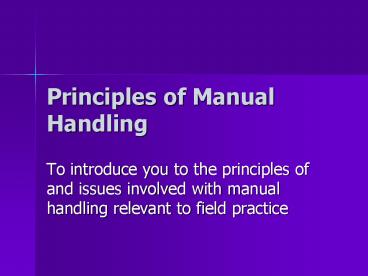Principles of Manual Handling - PowerPoint PPT Presentation
1 / 20
Title:
Principles of Manual Handling
Description:
Any activity requiring the use of force exerted by a person to lift, lower, push, ... To prevent overuse of small muscle groups such as upper traps and biceps. ... – PowerPoint PPT presentation
Number of Views:1250
Avg rating:3.0/5.0
Title: Principles of Manual Handling
1
Principles of Manual Handling
- To introduce you to the principles of and issues
involved with manual handling relevant to field
practice
2
Manual Handling
- What is manual handling?
- Any activity requiring the use of force exerted
by a person to lift, lower, push, pull, carry or
otherwise move, hold or restrain any person,
animal or thing (OHSW (Manual Handling)
Regulations, 1990) - You need to comment on manual handling in your
field practice workbook any policies, training
or experiences you have on field practice
3
Manual Handling
- More than lifting
- How you use your body in the most effective and
safe way in relation to a load may involve
lifting, carrying, pushing, pulling, lowering or
sustained postures - You have a duty of care and legal obligations to
work safely
4
Manual Handling
- Back injuries represent 25 of work related
injuries in SA - As a student, you may encounter circumstances
that could place you at risk of a back or other
type of injury - setting up materials for a treatment session
- assisting with transfers and mobility including
using a mechanical lifter - moving equipment into and out of a vehicle
- poor posture when making a splint
5
Principles of MH
- Safety of yourself and your client
- Work within your capabilities
- NEVER attempt a transfer or other activity if you
are not confident that you know exactly what is
expected of you and that you have the skills and
capability required - Number 1 rule
- STOP AND THINK
6
Assessing risk factors
- Stop, look and think
- Can you minimize the need for and risk involved
by - Modifying the object
- Modifying the environment
7
Assessing risk factors
- Stop, look and think
- Can you minimize the need for and risk involved
by - modifying the object and/or the environment?
- Person (you)
- Strength, fitness, health, MH skills, body
position - Environment
- Start and finish, help available
- Occupation (what you will be moving)
- An object, a person
8
Planning for transfers
- Consider the following rules
- Evaluate the task
- (Assess the patient)
- Organise assistance
- Check environmental safety factors
- Arrange furniture / other environmental aspects
- Care of your own body position
- PLANNING TAKES UP 90 OF MH TIME
9
Evaluate the task
- What needs to be done?
- Is there anyway the task can be made easier (eg
take wheelchair apart) - What is in the way?
- Is there any equipment needed?
- Will you need help?
10
Evaluate the task
- What can the patient/client do for themselves?
- Never help more than you need to try verbal
instructions, demonstration - Understanding normal biomechanics of a task is
important - Eg assisting someone from sit to stand
11
Check environmental safety factors
- Environment
- Adequate space available? surface (eg sloping
driveway, water on floor)? Adequate length of
attachments, obstacles in the way - Brakes on beds and chairs
- Prepare environment
- Start position (brakes on chair moving from)
- End position (brakes on, chair in suitable
position and prepared, eg with sheet on it) - If the patient has a distance to walk, you might
want to place chairs at convenient places in case
breaks are required as well.
12
Looking after yourself
- Maintain natural spinal curves
- In standing
- When getting lower down
- When bending forward
13
Looking after yourself
- STABLE CORE
- Abdominal bracing
- A little anatomy revision transversus abdominus
- Scapula bracing
- To prevent overuse of small muscle groups such as
upper traps and biceps. Also helps to keep load
close - Use large muscle groups
- Quads, gluts ie bend the knees
14
Looking after yourself
- Wide and stable base of support
- feet position, weight shift
- Keep load close to you
- Hand placement
- Listen to your body and be aware of early warning
signs of injury
15
Looking after yourself
- These principles apply to
- all types of MH including using assistive devices
- all movement and sustained postures
16
Lets practice!
- In pairs, move your bag/chair/table the way you
usually would. Critique each other using the
effective MH principles. - Now do it again, consciously using the effective
MH principles. Critique each other again. - What areas of your own technique do you need to
work on?
17
Manual Handling - scenario
- In order to accompany a client from hospital to
home to assess the home environment, you need to - (a) assist her from the wheelchair into the car
and - (b) load her folding wheelchair into the boot of
the hospital sedan - What are the potential risks in this situation?
Use PEO to help identify them. - How can you achieve this while minimising your
risk of a manual handling injury?
18
Remember planning is 90 of all MH
19
Conclusion
- You will encounter manual handling on FP
- You have a duty of care and legal obligations to
work safely - Stop, look and think and use PEO to assess risk
factors - Use your skills to modify the task and
environment - Dont do anything you are not confident to do
20
Conclusion
- You will see examples of good and bad MH
- Use your workbook to reflect on both and learn
from the bad as well as the good - For more information about field work in OT,
including general information about OHSWIM - http//www.unisanet.unisa.edu.au/learn/HSCPlacemen
ts/?PATH/Resources/hsc2Dplacements/Students/def
aultWelcome.htm































